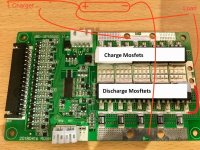Darren2018
100 W
- Joined
- Aug 18, 2018
- Messages
- 223
Hi,
I ordered the Smart BMS from Greenbikekit as 14S and I want to be able to change it to 13S if I need to incase I can't squeeze all 70 cells plus the BMS into the Hailong case. I noticed there is a solder bridge between the balance leads of cells 13 and 14 and was wondering if this has something to do with it as I spoke to GBK and they said it can't be done as they pre config the boards before they send them out, I can't imagine it can't be done via either the hardware or the software but I just need to know how. Here is a pic of the board I have. Also does anyone know how much power will be wasted as heat through these 12X (I'm assuming they are all used for charging/discharging) KIA Semicon Tech KNB3308A FETs on a 52V pack with a 30A load? I want to remove the heatsinks to gain space if I need it but I don't want to burn up the FET's. Here is the data sheet https://lcsc.com/product-detail/MOSFET_KNB3308A_C176861.html
I ordered the Smart BMS from Greenbikekit as 14S and I want to be able to change it to 13S if I need to incase I can't squeeze all 70 cells plus the BMS into the Hailong case. I noticed there is a solder bridge between the balance leads of cells 13 and 14 and was wondering if this has something to do with it as I spoke to GBK and they said it can't be done as they pre config the boards before they send them out, I can't imagine it can't be done via either the hardware or the software but I just need to know how. Here is a pic of the board I have. Also does anyone know how much power will be wasted as heat through these 12X (I'm assuming they are all used for charging/discharging) KIA Semicon Tech KNB3308A FETs on a 52V pack with a 30A load? I want to remove the heatsinks to gain space if I need it but I don't want to burn up the FET's. Here is the data sheet https://lcsc.com/product-detail/MOSFET_KNB3308A_C176861.html



